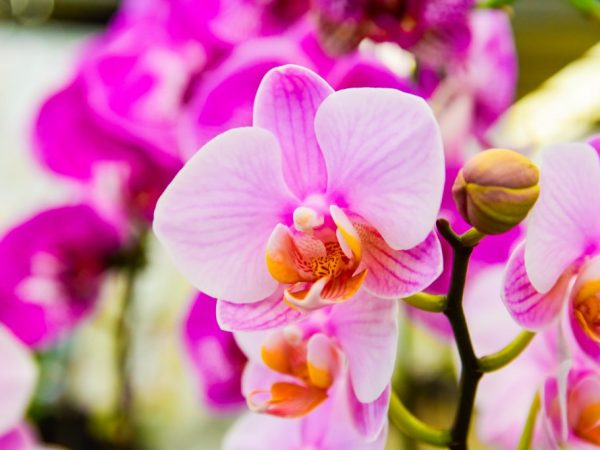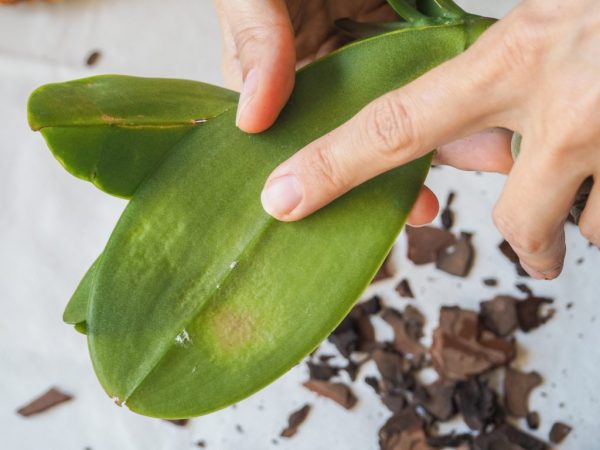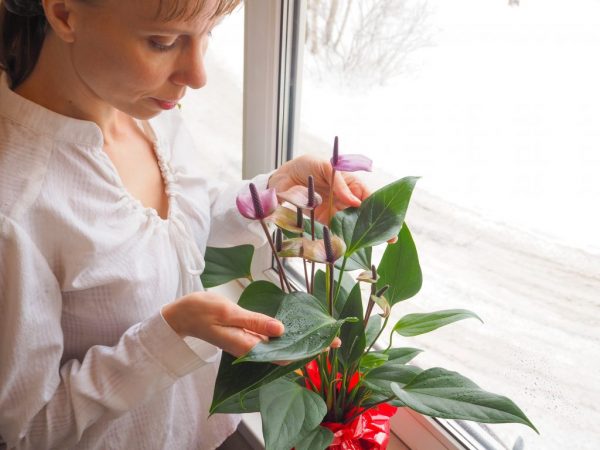Reasons for the appearance of sticky drops on an orchid
The appearance of sticky spots on the foliage, as well as on the branches, peduncle and stem of the phalaenopsis orchid is a reason to think about the health and condition of the flower. Sticky drops on orchid leaves can appear for various reasons, from improper plant care to a serious disease that leads to the death of the flower.

Reasons for the appearance of sticky drops on an orchid
Improper care
Sticky drops on orchid leaves are called extra-flowering nectar. They can appear on the stem, leaves, bulb, peduncle.
There are various reasons why orchids develop a sticky coating. Among them there are quite harmless ones:
- A natural process for the formation of flower nectar. Usually, sticky spots on the foliage and trunk form on young flowers. And in this case, there is no danger to the plant. The resulting liquid will also not bring harm. To make sure it is harmless, inspect the flower for worms or leaf cutters.
- Another harmless reason why orchid leaves become sticky is over-fertilization combined with watering. If you adjust the feeding and watering, the plant will recover.
However, if such a plaque appears on the phalaenopsis orchid and persists, most likely the plant is sick.
Diseases and pests
Not always transparent or white drops appear for harmless reasons. Sometimes this is a consequence of a disease or damage to the flower.
Harmful insects
If sticky drops appear on the orchid, this indicates an infection of the plant with domestic parasites - aphids, ticks or worms. If small dots are visible on the droplets, this indicates the presence of small pests in the plaque. A sticky white coating on indoor flowers, especially in the leaf area, appears for the same reason.

White droplets can be a sign of flower disease.
Powdery mildew
The appearance of sticky drops on the leaves of the phalaenopsis orchid is a consequence of infection with powdery mildew. This is the name of one of the most common fungal diseases .. It is caused by small fungi, the spores of which are easily carried through the air and secrete a sticky substance.
In the second stage of this disease, white spots appear on the leaves of the flower, after which they turn brown or black.
The above reasons are the most popular in the practice of growing this flower and the appearance of a sticky and white bloom on its surface.
It is important for a gardener or florist to know how to eliminate this problem and how to properly treat a flower from a disease, including home remedies.
Treatment methods
If you have taken into account all the recommendations: reduced the number of watering and fertilizing, created favorable conditions, moistened the room, wiped all the leaves with water and soap, and the sticky drops on the orchid do not disappear, you should immediately take measures to cure the flower disease.
Treatment will depend on the cause of the appearance of such a plaque:
- They begin to fight by replacing watering with soaking the flower twice a month. Clean and warm water is poured into the container, and then add several tablets to it, designed to combat fungal infections that affect indoor flowers. After that, the orchid must be placed together with the pot in this container and left in this position for 20-30 minutes.
- If the orchid has sticky leaves, reduce the amount of watering in the winter. This measure is especially necessary if the foliage is covered with such a bloom both above and below. In humid conditions, infections develop and bacteria spread.
- Treatment will give favorable results if the flower is constantly sprayed with a specially prepared solution of water mixed with an antifungal drug. The water should be clean and warm.
- If the plant is covered with a lot of pests, you can pick them by hand. If a flower is damaged by a mealybug, the orchid should be watered with warm water (not lower than 40-45 °), and then treated with preparations that contain oil. If you notice ticks on the flower, then removing the affected parts of the plant, transplanting it and rinsing the pot will help get rid of it. If there are a lot of pests - insects on the flower, then purchase drugs such as Fozalon or Phosphamide. You can buy them at any gardening store.

Flower treatment methods
Keep in mind that the flower problem has a deeper cause. For example, powdery mildew appears on plants that grow indoors with insufficient light levels - as a result, plaque appears.
If a sticky bloom appears on the leaves of indoor orchids in the summer, then this was a consequence of too low humidity in the room. Wipe the leaves with a damp cloth to keep them fresh and absorb moisture.
Disease prevention
To prevent sticky drops from appearing on orchid leaves, take preventive measures.
Firstly, it is worth paying special attention to the cultivation and maintenance of an orchid. Observe the temperature regime, regular watering and fertilization. Monitor the humidity and light levels in the room. Do not place flower pots in direct sunlight.
Second, inspect the plants regularly. If you notice the appearance of sticky drops or plaque at an early stage, you can quickly get rid of this phenomenon, cure the disease.
Also, if you notice a change in any one flower, then the rest of the plants must be isolated from the diseased specimen until it fully recovers.
Conclusion
As you can see, the reasons for the sticky leaves on the phalaenopsis orchid are different. If you follow all the rules for care and timely inspect flowers for diseases and pests, you will never have to face this problem.


